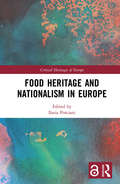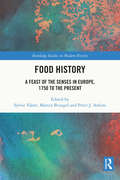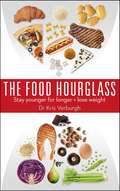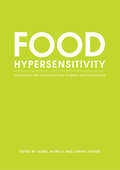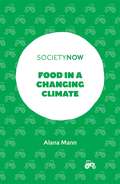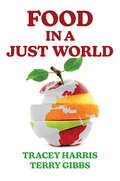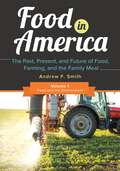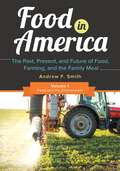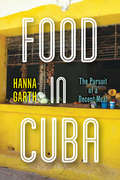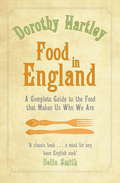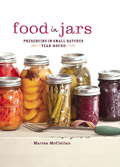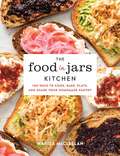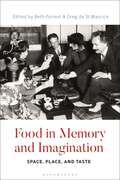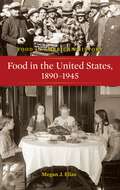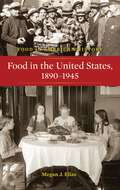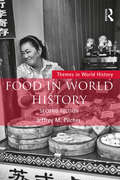- Table View
- List View
Food Heritage and Nationalism in Europe (Critical Heritages of Europe)
by Ilaria PorcianiFood Heritage and Nationalism in Europe contends that food is a fundamental element of heritage, and a particularly important one in times of crisis. Arguing that food, taste, cuisine and gastronomy are crucial markers of identity that are inherently connected to constructions of place, tradition and the past, the book demonstrates how they play a role in intangible, as well as tangible, heritage. Featuring contributions from experts working across Europe and beyond, and adopting a strong historical and transnational perspective, the book examines the various ways in which food can be understood and used as heritage. Including explorations of imperial spaces, migrations and diasporas; the role of commercialisation processes, and institutional practices within political and cultural domains, this volume considers all aspects of this complex issue. Arguing that the various European cuisines are the result of exchanges, hybridities and complex historical processes, Porciani and the chapter authors offer up a new way of deconstructing banal nationalism and of moving away from the idea of static identities. Suggesting a new and different approach to the idea of so-called national cuisines, Food Heritage and Nationalism in Europe will be a compelling read for academic audiences in museum and heritage studies, cultural and food studies, anthropology and history. Chapters 1,2,4,6 and 12 of this book are available for free in PDF format as Open Access from the individual product page at www.routledge.com. They have been made available under a Creative Commons Attribution-Non Commercial-No Derivatives 4.0 license
Food History: A Feast of the Senses in Europe, 1750 to the Present (Routledge Studies in Modern History)
by Sylvie Vabre Martin Bruegel Peter J. AtkinsThis pioneering book elevates the senses to a central role in the study of food history because the traditional focus upon food types, quantities, and nutritional values is incomplete without some recognition of smell, touch, sight, hearing, and taste. Eating is a sensual experience. Every day and at every meal the senses of smell, touch, sight, hearing, and taste are engaged in the acts of preparation and consumption. And yet these bodily acts are ephemeral; their imprint upon the source material of history is vestigial. Hitherto historians have shown little interest in the senses beyond taste, and this book fills that research gap. Four dimensions are treated: • Words, Symbols and Uses: Describing the Senses – an investigation of how specific vocabularies for food are developed. • Industrializing the Senses – an analysis of the fundamental change in the sensory qualities of foods under the pressure of industrialization and economic forces outside the control of the household and the artisan producer. • Nationhood and the Senses – an exploration of how the combination of the senses and food play into how nations saw themselves, and how food was a signature of how political ideologies played out in practical, everyday terms. • Food Senses and Globalization – an examination of links between food, the senses, and the idea of international significance. Putting all of the senses on the agenda of food history for the first time, this is the ideal volume for scholars of food history, food studies and food culture, as well as social and cultural historians. Putting all of the senses on the agenda of food history for the first time, this is the ideal volume for scholars of food history, food studies and food culture, as well as social and cultural historians.
Food History: A Feast of the Senses in Europe, 1750 to the Present (Routledge Studies in Modern History)
by Sylvie Vabre Martin Bruegel Peter J. AtkinsThis pioneering book elevates the senses to a central role in the study of food history because the traditional focus upon food types, quantities, and nutritional values is incomplete without some recognition of smell, touch, sight, hearing, and taste. Eating is a sensual experience. Every day and at every meal the senses of smell, touch, sight, hearing, and taste are engaged in the acts of preparation and consumption. And yet these bodily acts are ephemeral; their imprint upon the source material of history is vestigial. Hitherto historians have shown little interest in the senses beyond taste, and this book fills that research gap. Four dimensions are treated: • Words, Symbols and Uses: Describing the Senses – an investigation of how specific vocabularies for food are developed. • Industrializing the Senses – an analysis of the fundamental change in the sensory qualities of foods under the pressure of industrialization and economic forces outside the control of the household and the artisan producer. • Nationhood and the Senses – an exploration of how the combination of the senses and food play into how nations saw themselves, and how food was a signature of how political ideologies played out in practical, everyday terms. • Food Senses and Globalization – an examination of links between food, the senses, and the idea of international significance. Putting all of the senses on the agenda of food history for the first time, this is the ideal volume for scholars of food history, food studies and food culture, as well as social and cultural historians. Putting all of the senses on the agenda of food history for the first time, this is the ideal volume for scholars of food history, food studies and food culture, as well as social and cultural historians.
The Food Hourglass
by Dr Kris VerburghStay younger for longer and get the body you’ve always dreamed of. Join the health revolution taking the world by storm!
Food Hydrocolloids as Encapsulating Agents in Delivery Systems
by Adil Gani F. A. Masoodi Umar Shah Shah AsimaThis book addresses the use of food hydrocolloids as agents for encapsulating biological active ingredients. It details the challenges of poorly-controlled rate of hydration, thickness, decrease in viscosity upon storage, and susceptibility to microbial contamination. Food Hydrocolloids as Encapsulating Agents in Delivery Systems briefly describes various emerging biomaterials including food gums, starches, beta glucans, and proteins for their potential role as wall material in the development of nutraceutical delivery systems. Further, it describes different techniques of fabrication of nanodelivery systems. Features: Provides an introduction to food hydrocolloids as encapsulating agents Covers starches and their derivatives as delivery systems Includes gum-based delivery systems Discusses the classification, isolation, and purification of protein delivery systems This book would be helpful to food scientists and pharmaceutical scientists working in areas including nanotechnology, polymer chemistry, and nutraceutical delivery, as well as regulators and government researchers in US FDA, USDA, and UK FSA regulatory agencies.
Food Hydrocolloids as Encapsulating Agents in Delivery Systems
by Adil Gani F. A. Masoodi Umar Shah Shah AsimaThis book addresses the use of food hydrocolloids as agents for encapsulating biological active ingredients. It details the challenges of poorly-controlled rate of hydration, thickness, decrease in viscosity upon storage, and susceptibility to microbial contamination. Food Hydrocolloids as Encapsulating Agents in Delivery Systems briefly describes various emerging biomaterials including food gums, starches, beta glucans, and proteins for their potential role as wall material in the development of nutraceutical delivery systems. Further, it describes different techniques of fabrication of nanodelivery systems. Features: Provides an introduction to food hydrocolloids as encapsulating agents Covers starches and their derivatives as delivery systems Includes gum-based delivery systems Discusses the classification, isolation, and purification of protein delivery systems This book would be helpful to food scientists and pharmaceutical scientists working in areas including nanotechnology, polymer chemistry, and nutraceutical delivery, as well as regulators and government researchers in US FDA, USDA, and UK FSA regulatory agencies.
Food Hypersensitivity: Diagnosing and Managing Food Allergies and Intolerance
by Isabel Skypala Carina VenterSpecialist dietitians, Isabel Skypala and Carina Venter assemble a team of expert authors to separate fact from fiction and provide the reader with an authoritative and practical guide to handling the difficult issue of food hypersensitivity. Offering advice for treating children and adults in one book and written in an accessible style, the book is split into three main sections: Diagnosis Dietary management Allergy prevention and nutritional considerations This exceptional volume is essential reading for all dietitans, nutritionists, paediatricians, allergists, family practitioners, GPs, practice nurses, health visitors and other health care professionals who work in this area or have an interest in food allergy. The book is also an excellent reference for undergraduate and postgraduate students studying allergy, immunology or nutrition and dietetics. Libraries in all universities and research establishments where nutrition, dietetics, food science, medicine and health sciences are studied and taught should have copies of this important work on their shelves
Food in a Changing Climate (SocietyNow)
by Alana MannOur diets are going to change dramatically as global warming affects growing seasons and the availability of different foods around the world. Meanwhile, our foodways are among the biggest contributors to greenhouse gas emissions. To address these challenges Food in a Changing Climate demands we look beyond our plates to the roots of inequity in our food systems. It presents an unashamedly political agenda for 'deep adaptation', focused on the rejuvenation and strengthening of local and regional food systems that have been steadily eroded in the name of economic efficiency. The colonial origins of fossil-fuel based food production and trade persist in the marginalisation of farmers, food workers, and fishers in a corporatized food system that promotes the exploitation of the environment, excess production, and hyper-consumerism. These factors contribute to climate change, poverty, and health inequities on a global scale. Drawing on case studies from around the world, this book illustrates how the commodification of food has made us particularly vulnerable to climate change, extreme weather events, and pandemics such as COVID19. These shocks reveal the danger of our reliance on increasingly complex supply chains - dominated by a decreasing number of mega-companies - for our food security. The unsustainability of the way we produce and eat food is clear. It has been for a long time. Food in a Changing Climate explores how we can cultivate resilient communities through the just application of new technologies, the recovery of traditional knowledges, and by building diversity to protect the livelihoods of food producers everywhere.
Food in a Changing Climate (SocietyNow)
by Alana MannOur diets are going to change dramatically as global warming affects growing seasons and the availability of different foods around the world. Meanwhile, our foodways are among the biggest contributors to greenhouse gas emissions. To address these challenges Food in a Changing Climate demands we look beyond our plates to the roots of inequity in our food systems. It presents an unashamedly political agenda for 'deep adaptation', focused on the rejuvenation and strengthening of local and regional food systems that have been steadily eroded in the name of economic efficiency. The colonial origins of fossil-fuel based food production and trade persist in the marginalisation of farmers, food workers, and fishers in a corporatized food system that promotes the exploitation of the environment, excess production, and hyper-consumerism. These factors contribute to climate change, poverty, and health inequities on a global scale. Drawing on case studies from around the world, this book illustrates how the commodification of food has made us particularly vulnerable to climate change, extreme weather events, and pandemics such as COVID19. These shocks reveal the danger of our reliance on increasingly complex supply chains - dominated by a decreasing number of mega-companies - for our food security. The unsustainability of the way we produce and eat food is clear. It has been for a long time. Food in a Changing Climate explores how we can cultivate resilient communities through the just application of new technologies, the recovery of traditional knowledges, and by building diversity to protect the livelihoods of food producers everywhere.
Food in a Just World: Compassionate Eating in a Time of Climate Change
by Tracey Harris Terry GibbsFood in a Just World examines the violence, social breakdown, and environmental consequences of our global system of food production, distribution, and consumption, where each step of the process is built on some form of exploitation. While highlighting the broken system’s continuities from European colonialism, the authors argue that the seeds of resilience, resistance, and inclusive cultural resurgence are already being reflected in the day-to-day actions of communities around the world. Calling for urgent change, the book looks at how genuine democracy would give individuals and communities meaningful control over the decisions that impact their lives when seeking to secure humanely this most basic human need. Drawing on the perspectives of advocates, activists, workers, researchers, and policymakers, Harris and Gibbs explore the politics of food in the context of capitalist globalization and the climate crisis, uncovering the complexities in our relationships with one another, with other animals, and with the natural world.
Food in America [3 volumes]: The Past, Present, and Future of Food, Farming, and the Family Meal [3 volumes]
by Andrew F. SmithThis three-volume work examines all facets of the modern U.S. food system, including the nation's most important food and agriculture laws, the political forces that shape modern food policy, and the food production trends that are directly impacting the lives of every American family.Americans are constantly besieged by conflicting messages about food, the environment, and health and nutrition. Are foods with genetically modified ingredients safe? Should we choose locally grown food? Is organic food better than conventional food? Are concentrated animal feed operations destroying the environment? Should food corporations target young children with their advertising and promotional campaigns? This comprehensive three-volume set addresses all of these questions and many more, probing the problems created by the industrial food system, examining conflicting opinions on these complex food controversies, and highlighting the importance of food in our lives and the decisions we make each time we eat.The coverage of each of the many controversial food issues in the set offers perspectives from different sides to encourage readers to examine various viewpoints and make up their own minds. The first volume, Food and the Environment, addresses timely issues such as climate change, food waste, pesticides, and sustainable foods. Volume two, entitled Food and Health and Nutrition, addresses subjects like antibiotics, food labeling, and the effects of salt and sugar on our health. The third volume, Food and the Economy, tackles topics such as food advertising and marketing, food corporations, genetically modified foods, globalization, and megagrocery chains. Each volume contains several dozen primary documents that include firsthand accounts written by promoters and advertisers, journalists, politicians and government officials, and supporters and critics of various views related to food and beverages, representing speeches, advertisements, articles, books, portions of major laws, and government documents, to name a few. These documents provide readers additional resources from which to form informed opinions on food issues.
Food in America [3 volumes]: The Past, Present, and Future of Food, Farming, and the Family Meal [3 volumes]
by Andrew F. SmithThis three-volume work examines all facets of the modern U.S. food system, including the nation's most important food and agriculture laws, the political forces that shape modern food policy, and the food production trends that are directly impacting the lives of every American family.Americans are constantly besieged by conflicting messages about food, the environment, and health and nutrition. Are foods with genetically modified ingredients safe? Should we choose locally grown food? Is organic food better than conventional food? Are concentrated animal feed operations destroying the environment? Should food corporations target young children with their advertising and promotional campaigns? This comprehensive three-volume set addresses all of these questions and many more, probing the problems created by the industrial food system, examining conflicting opinions on these complex food controversies, and highlighting the importance of food in our lives and the decisions we make each time we eat.The coverage of each of the many controversial food issues in the set offers perspectives from different sides to encourage readers to examine various viewpoints and make up their own minds. The first volume, Food and the Environment, addresses timely issues such as climate change, food waste, pesticides, and sustainable foods. Volume two, entitled Food and Health and Nutrition, addresses subjects like antibiotics, food labeling, and the effects of salt and sugar on our health. The third volume, Food and the Economy, tackles topics such as food advertising and marketing, food corporations, genetically modified foods, globalization, and megagrocery chains. Each volume contains several dozen primary documents that include firsthand accounts written by promoters and advertisers, journalists, politicians and government officials, and supporters and critics of various views related to food and beverages, representing speeches, advertisements, articles, books, portions of major laws, and government documents, to name a few. These documents provide readers additional resources from which to form informed opinions on food issues.
Food in Cuba: The Pursuit of a Decent Meal
by Hanna GarthFood in Cuba follows Cuban families as they struggle to maintain a decent quality of life in Cuba's faltering, post-Soviet welfare state by specifically looking at the social and emotional dimensions of shifts in access to food. Based on extensive fieldwork with families in Santiago de Cuba, the island's second largest city, Hanna Garth examines Cuban families' attempts to acquire and assemble "a decent meal," unraveling the layers of household dynamics, community interactions, and individual reflections on everyday life in today's Cuba. With the collapse of the Soviet Union in the 1990s and the subsequent loss of its most significant trade partner, Cuba entered a period of economic hardship. Although trade agreements have significantly improved the quantity and quality of rationed food in Cuba, many Cubans report that they continue to live with food shortages and economic hardship. Garth tells the stories of families that face the daily challenge of acquiring not only enough food, but food that meets local and personal cultural standards. She ultimately argues that these ongoing struggles produce what the Cuban families describe as "a change in character," and that for some, this shifting concept of self and sense of social relation leads to a transformation in society. Food in Cuba shows how the practices of acquisition and the politics of adequacy are intricately linked to the local moral stances on what it means to be a good person, family member, community member, and ultimately, a good Cuban.
Food In England: A complete guide to the food that makes us who we are
by Dorothy HartleyHer love of the infinite variety of English cooking and her knowledge of British culture and history show why our food should never be considered dull or limited. There are unusual dishes such as the Cornish Onion and Apple Pie, and even recipes for fungi, from common field mushrooms to puffballs. She describes some delicious puddings, cakes and breads, including an exotic violet flower ice cream, an eighteenth century coconut bread and Yorkshire teacakes. The finely-executed line drawings that accompany many of the recipes are more than just beautiful; they inform the cook about different varieties and techniques of food-handling. First published in 1954, FOOD IN ENGLAND was the bible of english cooks and had a deep influence on many contemporary cooks and food writers. It will undoubtedly attract a new generation of admirers.
Food in Jars: Preserving in Small Batches Year-Round
by Marisa McClellanMarisa McClellan's first book for accessible home preserving for jams, jellies, pickles, chutneys, and more, as seen on her beloved food blog Food in Jars. Popular food blogger and doyenne of canning, Marisa McClellan, is using small batches and inventive flavors to make preserving easy enough for any novice to tackle. If you grew up eating home-preserved jams and pickles, or even if you're new to putting up, you'll find recipes to savor. Sample any of the 100 seasonal recipes: In the spring: Apricot Jam and Rhubarb Syrup In the summer: Blueberry Butter and Peach Salsa In the fall: Dilly Beans and Spicy Pickled Cauliflower In the winter: Three-Citrus Marmalade and Cranberry Ketchup Marisa's confident, practical voice answers questions and quells any fears of accidental canning mistakes, and the book is written for cooks of any skill level. Stories of wild blackberry jam and California Meyer lemon marmalade from McClellan's childhood make for a read as pleasurable as it is delicious; her home-canned food-learned from generations of the original "foodies"-feeds the soul as well as the body.
The Food in Jars Kitchen: 140 Ways to Cook, Bake, Plate, and Share Your Homemade Pantry
by Marisa McClellanThe book Food in Jars readers have been waiting for: 140 recipes for the preserving kitchen, helping you use up your homemade pantry!Marisa McClellan wants everyone to know that a pantry full of homemade jams, jellies, salsas, and pickles can do a whole lot more than accompany toast. They can add bold bursts of flavor to your home cooking! In her fourth book, she provides 140 recipes for incorporating preserves into everyday dishes. It is as simple as stirring applesauce into a dish of baked oatmeal, brushing apricot jam onto a whole chicken, or building your pasta salad with a jar of pickled vegetables. Recipes include: Jam-Filled Biscuits Preserved Lemon Hummus Strawberry Basil Pizza Jam-Lacquered Chicken Wings Lemon Curd and Blueberry Tart Pantry Sangria With chapters focusing on great ways to use preserves throughout the day and for every meal, readers aren't required to have a specific preserve on hand to work, making this cookbook flexible and easy to use for both experienced and novice canners. As one of the most beloved voices in canning and preserving, Marisa serves as a kitchen muse to help each reader complete the cycle of empty jar to empty jar. Add The Food in Jars Kitchen to your collection, an inspired workhorse of delicious eats.
The Food in Jars Kitchen: 140 Ways to Cook, Bake, Plate, and Share Your Homemade Pantry
by Marisa McClellanThe book Food in Jars readers have been waiting for: 140 recipes for the preserving kitchen, helping you use up your homemade pantry!Marisa McClellan wants everyone to know that a pantry full of homemade jams, jellies, salsas, and pickles can do a whole lot more than accompany toast. They can add bold bursts of flavor to your home cooking! In her fourth book, she provides 140 recipes for incorporating preserves into everyday dishes. It is as simple as stirring applesauce into a dish of baked oatmeal, brushing apricot jam onto a whole chicken, or building your pasta salad with a jar of pickled vegetables. Recipes include:Jam-Filled Biscuits Preserved Lemon Hummus Strawberry Basil Pizza Jam-Lacquered Chicken Wings Lemon Curd and Blueberry Tart Pantry Sangria With chapters focusing on great ways to use preserves throughout the day and for every meal, readers aren't required to have a specific preserve on hand to work, making this cookbook flexible and easy to use for both experienced and novice canners. As one of the most beloved voices in canning and preserving, Marisa serves as a kitchen muse to help each reader complete the cycle of empty jar to empty jar. Add The Food in Jars Kitchen to your collection, an inspired workhorse of delicious eats.
Food in Memory and Imagination: Space, Place and, Taste
by Beth M. Forrest and Greg de St MauriceHow do we engage with food through memory and imagination? This expansive volume spans time and space to illustrate how, through food, people have engaged with the past, the future, and their alternative presents.Beth M. Forrest and Greg de St. Maurice have brought together first-class contributions, from both established and up-and-coming scholars, to consider how imagination and memory intertwine and sometimes diverge. Chapters draw on cases around the world-including Iran, Italy, Japan, Kenya, and the US-and include topics such as national identity, food insecurity, and the phenomenon of knowledge. Contributions represent a range of disciplines, including anthropology, history, philosophy, psychology, and sociology. This volume is a veritable feast for the contemporary food studies scholar.
Food in Memory and Imagination: Space, Place and, Taste
by Beth Forrest Greg De St MauriceHow do we engage with food through memory and imagination? This expansive volume spans time and space to illustrate how, through food, people have engaged with the past, the future, and their alternative presents.Beth M. Forrest and Greg de St. Maurice have brought together first-class contributions, from both established and up-and-coming scholars, to consider how imagination and memory intertwine and sometimes diverge. Chapters draw on cases around the world-including Iran, Italy, Japan, Kenya, and the US-and include topics such as national identity, food insecurity, and the phenomenon of knowledge. Contributions represent a range of disciplines, including anthropology, history, philosophy, psychology, and sociology. This volume is a veritable feast for the contemporary food studies scholar.
Food in the United States, 1890-1945 (Food in American History)
by Megan J. EliasNo American history or food collection is complete without this lively insight into the radical changes in daily life from the Gilded Age to World War II, as reflected in foodways.From the Gilded Age to the end of World War II, what, where, when, and how Americans ate all changed radically. Migration to urban areas took people away from their personal connection to food sources. Immigration, primarily from Europe, and political influence of the Caribbean, Latin America, and the Pacific brought us new ingredients, cuisines, and foodways. Technological breakthroughs engendered the widespread availability of refrigeration, as well as faster cooking times. The invention of the automobile augured the introduction of "road food," and the growth of commercial transportation meant that a wider assortment of foods was available year round. Major food crises occurred during the Depression and two world wars. Food in the United States, 1890-1945 documents these changes, taking students and general readers through the period to explain what our foodways say about our society. This intriguing narrative is enlivened with numerous period anecdotes that bring America history alive through food history.
Food in the United States, 1890-1945 (Food in American History)
by Megan J. EliasNo American history or food collection is complete without this lively insight into the radical changes in daily life from the Gilded Age to World War II, as reflected in foodways.From the Gilded Age to the end of World War II, what, where, when, and how Americans ate all changed radically. Migration to urban areas took people away from their personal connection to food sources. Immigration, primarily from Europe, and political influence of the Caribbean, Latin America, and the Pacific brought us new ingredients, cuisines, and foodways. Technological breakthroughs engendered the widespread availability of refrigeration, as well as faster cooking times. The invention of the automobile augured the introduction of "road food," and the growth of commercial transportation meant that a wider assortment of foods was available year round. Major food crises occurred during the Depression and two world wars. Food in the United States, 1890-1945 documents these changes, taking students and general readers through the period to explain what our foodways say about our society. This intriguing narrative is enlivened with numerous period anecdotes that bring America history alive through food history.
Food in World History (Themes in World History)
by Jeffrey M. PilcherThe second edition of this concise survey offers a comparative and comprehensive study of culinary cultures and food politics throughout the world, from ancient times to the present day. It examines the long history of globalization of foods as well as the political, social, and environmental implications of our changing relationship with food, showing how hunger and taste have been driving forces in human history. Including numerous case studies from diverse societies and periods, Food in World History explores such questions as: What social factors have historically influenced culinary globalization? How did early modern plantations establish patterns for modern industrial food production? Were eighteenth-century food riots comparable to contemporary social movements around food? Did Italian and Chinese migrant cooks sacrifice authenticity to gain social acceptance in the Americas? Have genetically modified foods fulfilled the promises made by proponents? This new edition includes expanded discussions of gender and the family, indigeneity, and the politics of food. Expanded chapters on contemporary food systems and culinary pluralism examine debates over the concentration of corporate control over seeds and marketing, authenticity and exoticism within the culinary tourism industry, and the impact of social media on restaurants and home cooks.
Food in World History (Themes in World History)
by Jeffrey M. PilcherThe second edition of this concise survey offers a comparative and comprehensive study of culinary cultures and food politics throughout the world, from ancient times to the present day. It examines the long history of globalization of foods as well as the political, social, and environmental implications of our changing relationship with food, showing how hunger and taste have been driving forces in human history. Including numerous case studies from diverse societies and periods, Food in World History explores such questions as: What social factors have historically influenced culinary globalization? How did early modern plantations establish patterns for modern industrial food production? Were eighteenth-century food riots comparable to contemporary social movements around food? Did Italian and Chinese migrant cooks sacrifice authenticity to gain social acceptance in the Americas? Have genetically modified foods fulfilled the promises made by proponents? This new edition includes expanded discussions of gender and the family, indigeneity, and the politics of food. Expanded chapters on contemporary food systems and culinary pluralism examine debates over the concentration of corporate control over seeds and marketing, authenticity and exoticism within the culinary tourism industry, and the impact of social media on restaurants and home cooks.
Food in World History (Themes in World History)
by Jeffrey M. PilcherNow in its third edition, Food in World History explores culinary cultures and food politics throughout the world, from ancient times to the present day, with expanded discussions of industrialization, indigeneity, colonialism, gender, environment, and food and power. It examines the long history of globalization of foods as well as the political, social, and environmental implications of our changing relationship with food, showing how hunger and taste have been driving forces in human history. Including numerous case studies from diverse societies and periods, such as Maya and Inca cuisines and peasant agriculture in the early modern era, Food in World History explores such questions as: What social factors have historically influenced culinary globalization? How did early modern plantations establish patterns for modern industrial food production? How will the climate crisis affect food production and culinary cultures? Did Italian and Chinese migrant cooks sacrifice authenticity to gain social acceptance in the Americas? Have genetically modified foods fulfilled the promises made by proponents? With the inclusion of more global examples, this comprehensive survey is an ideal resource for all students who study food history or food studies.
Food in World History (Themes in World History)
by Jeffrey M. PilcherNow in its third edition, Food in World History explores culinary cultures and food politics throughout the world, from ancient times to the present day, with expanded discussions of industrialization, indigeneity, colonialism, gender, environment, and food and power. It examines the long history of globalization of foods as well as the political, social, and environmental implications of our changing relationship with food, showing how hunger and taste have been driving forces in human history. Including numerous case studies from diverse societies and periods, such as Maya and Inca cuisines and peasant agriculture in the early modern era, Food in World History explores such questions as: What social factors have historically influenced culinary globalization? How did early modern plantations establish patterns for modern industrial food production? How will the climate crisis affect food production and culinary cultures? Did Italian and Chinese migrant cooks sacrifice authenticity to gain social acceptance in the Americas? Have genetically modified foods fulfilled the promises made by proponents? With the inclusion of more global examples, this comprehensive survey is an ideal resource for all students who study food history or food studies.
